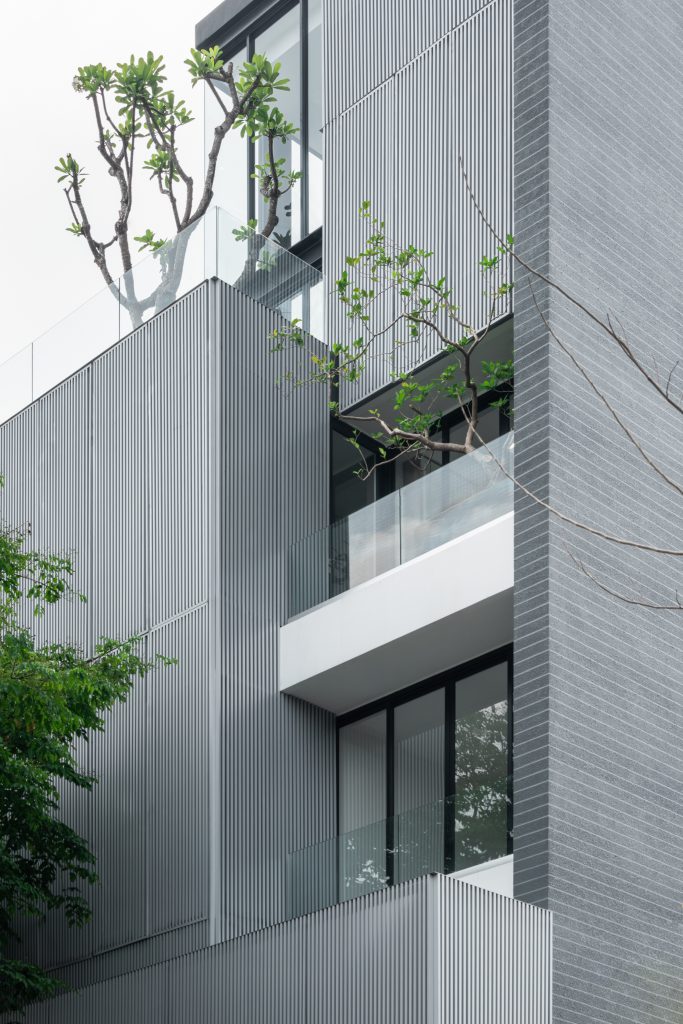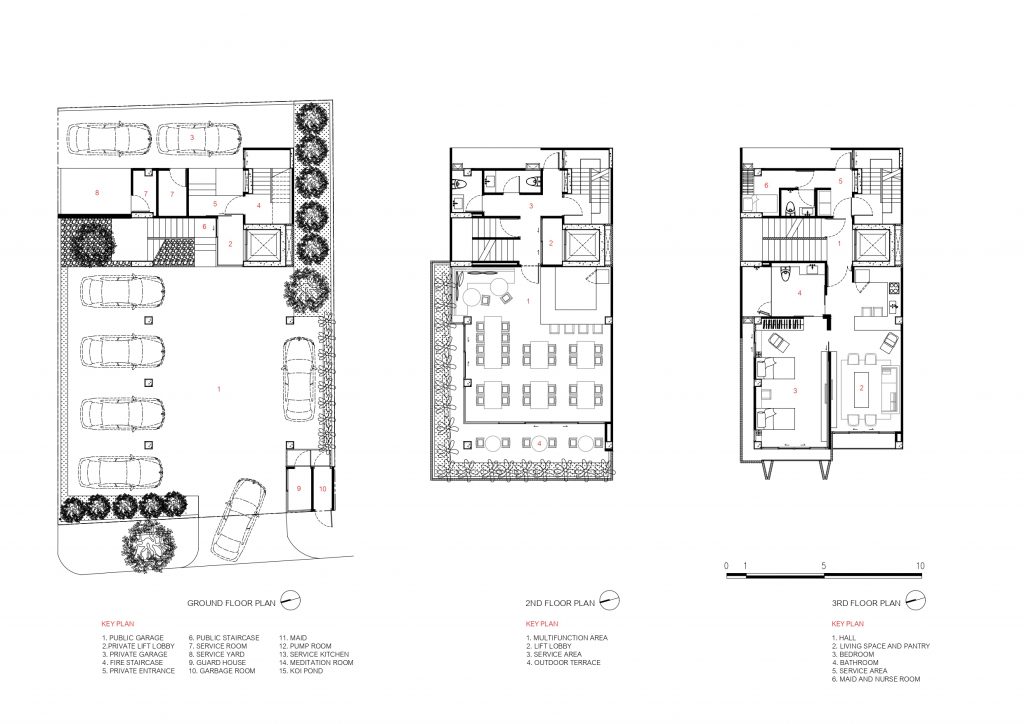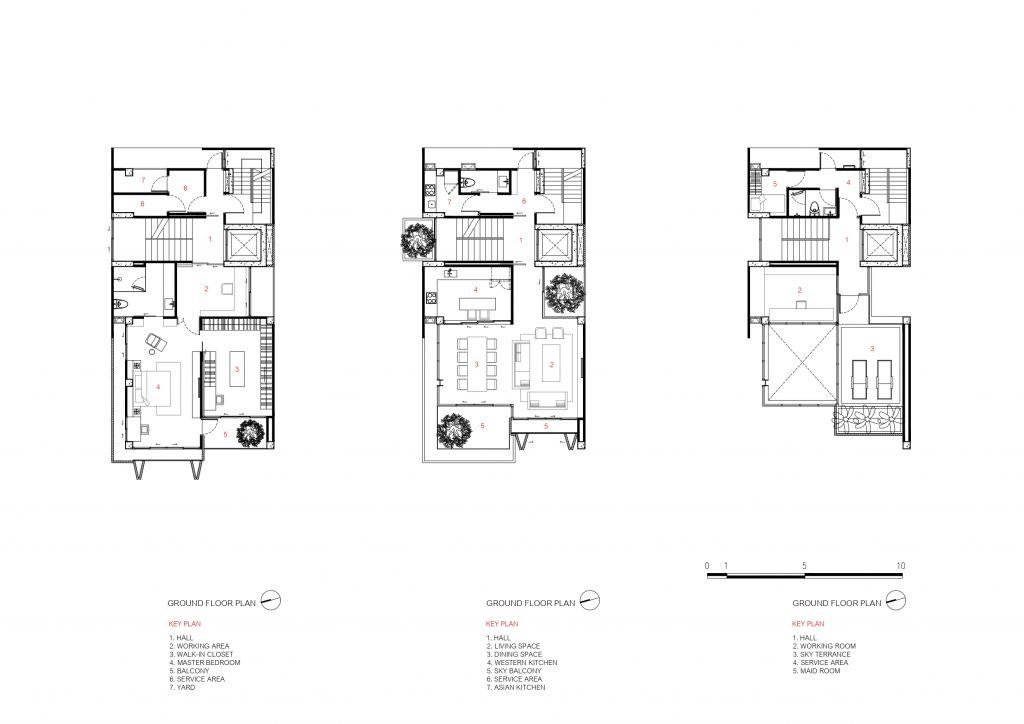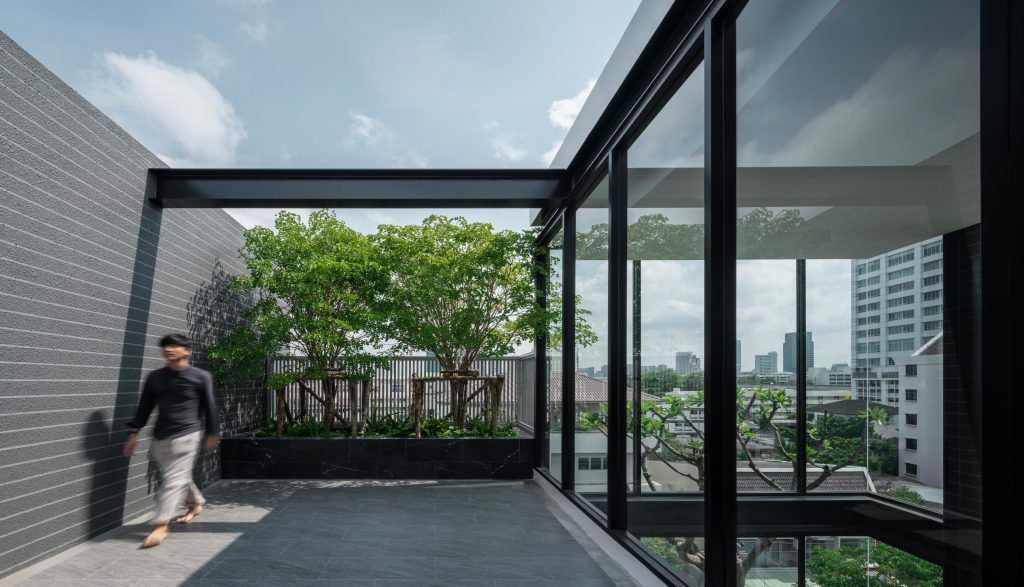The owners looked for a plot of land around here. Their brief was for a family home with an easy access route to the hospital for their parents. They also asked if it would be possible for the house to be used as a source of income post-retirement.
Text: Warut Duangkaewkart
Photo Courtesy of Ayutt and Associates design and Chalermwat Wongchompoo (Sofography) except as noted
Download the online journal Issue 05 Home Smart Home Click here
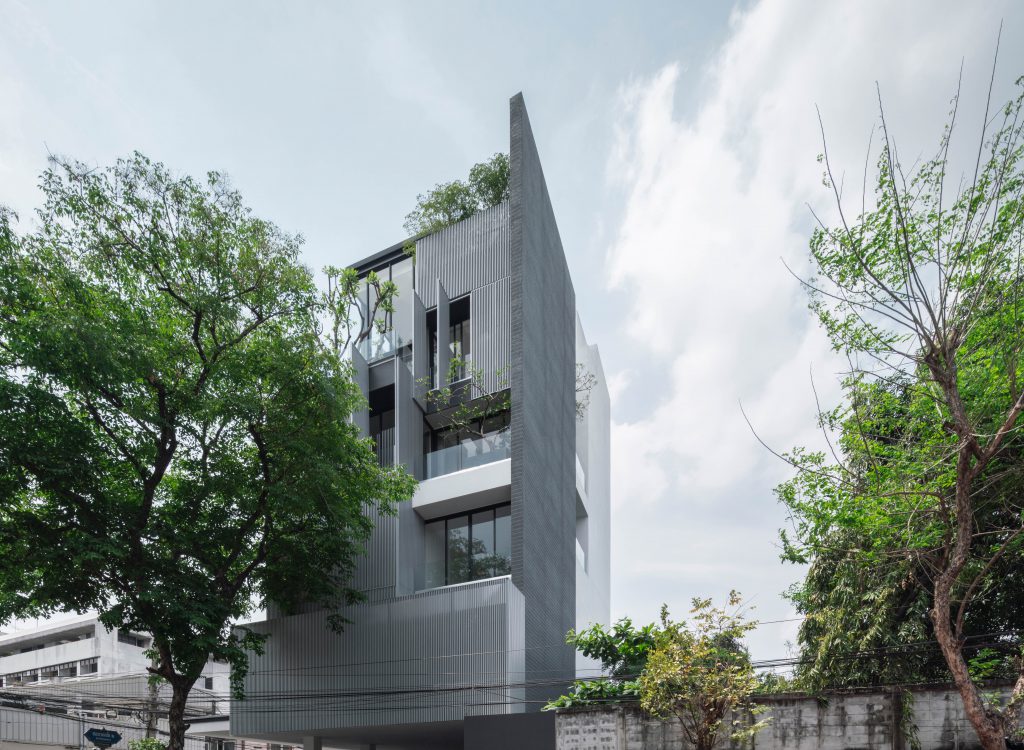
หลากหลายครั้ง ที่เรามักจะมองเห็นบทความ หรือการพูดถึงบ้านต่างๆ ในแง่ของความสวยงาม หลากหลายคน เลือกที่จะให้คุณค่ากับภาพที่มองเห็นจากภายนอก ของงานออกแบบสถาปัตยกรรมต่างๆ ซึ่งเราคงปฏิเสธไม่ได้ว่า ภาพลักษณ์ภายนอกนั้นเป็นองค์ประกอบสำคัญในการออกแบบ เป็นส่วนหนึ่งของงานทัศนศิลป์ที่รับรู้ด้วยการมองเห็น แต่ในขณะเดียวกัน คุณค่าของบ้าน หรืองานสถาปัตยกรรมใดๆ ก็ไม่ใช่เพียงแค่ความสวยงามเพียงอย่างเดียว ยังต้องประกอบไปด้วยการตอบโจทย์ของผู้ที่อยู่อาศัย แก้ปัญหาและสร้างคุณภาพชีวิตที่ดีให้กับผู้ใช้งานได้ ซึ่งในมุมของสถาปนิกที่ทำงานออกแบบนั้นเราสามารถนำความคิดสร้างสรรค์ เข้าไปจัดการได้อย่างไรบ้าง
“ทางเจ้าของบ้านมองหาที่ดินในย่านนี้ ซึ่งโจทย์ของบ้านหลังนี้คือการสร้างบ้านสำหรับครอบครัว ที่พ่อแม่สามารถเดินทางไปโรงพยาบาลได้สะดวก และมีไอเดียว่าจะเป็นไปได้ไหมว่าหลังจากเกษียณแล้ว บ้านหลังที่มีอยู่นั้นจะสามารถสร้างรายได้ให้ได้ด้วย” อยุทธ์ มหาโสม สถาปนิกกล่าวถึงที่มาของบ้านหลังนี้
บ้าน SETTHA เป็นอาคาร 6 ชั้น ออกแบบโดย AAd (Ayutt and Associates Design) ตั้งอยู่อย่างโดดเด่นบนที่ดินหัวมุม บนถนนเศรษฐสิริ กรุงเทพมหานคร ใกล้กับโรงพยาบาลวิชัยยุทธ จากภายนอกตัวอาคารประกอบไปด้วยกลุ่มก้อนอาคารที่ปิดทึบบางส่วนในชั้นล่าง และเปิดโล่งสำหรับชั้นบน ซึ่งตัวอาคารที่ดูโมเดิร์นนี้ ไม่ได้มีเพียงแค่รูปฟอร์มเท่านั้น แนวความคิดที่ซ่อนอยู่เบื้องหลังเองก็มีความน่าสนใจไม่ต่างกัน ด้วยการนำงานออกแบบอย่างชาญฉลาดมาแก้ไขปัญหา และตอบสนองความต้องการของเจ้าของบ้านทั้งในแง่ของการอยู่อาศัย และการตอบโจทย์เรื่องการเพิ่มมูลค่าให้กับบ้านหลังนี้ด้วย
ด้วยทำเลที่ตั้งแล้ว จากบ้านไปถึงโรงพยาบาล มีระยะห่างเพียง 200 เมตรเท่านั้น ทำให้เรื่องของการดูแลสุขภาพของครอบครัวกลายมาเป็นส่วนหนึ่งของแนวความคิดในการออกแบบ และจากเดิมที่พื้นที่นี้เป็นที่โล่งเพื่อให้เช่าเป็นที่จอดรถรายวัน – เดือน จึงทำให้มองเห็นถึงความเป็นไปได้ในการประยุกต์ฟังค์ชั่นต่างๆ ให้เกิดขึ้นได้ ที่จะทำให้บ้านหลังนี้เป็นบ้านสำหรับอยู่อาศัย และพื้นที่เชิงพาณิชย์ภายในอาคารเดียวกัน ด้วยขนาดพื้นที่ที่จำกัด บนที่ดินขนาด 75 ตารางวา พร้อมทั้งมีถนน 2 ด้าน ทำให้ระยะแนวร่นของอาคารนั้นเพิ่มมากขึ้นกว่าปกติ ตัวอาคารจึงถูกออกแบบให้เรียงตัวเป็นแนวตั้งขึ้นไป รวมถึงแบ่งพื้นที่ชัดเจนตั้งแต่ทางเข้า โดยแบ่งออกเป็นทางเข้าสำหรับส่วน Public และทางเข้าสำหรับเจ้าของบ้านที่ขยับเข้ามาอยู่ภายในซอย ช่วยให้เกิดการแบ่งการใช้งานของพื้นที่ภายในได้ดีขึ้นด้วยการสัญจร และพื้นที่ใช้งานของทั้ง 2 ส่วนถูกตัดขาดออกจากกันอย่างชัดเจน แม้จะยังสามารถเชื่อมถึงกันได้ แต่ก็มีความเป็นส่วนตัวอยู่ สอดคล้องไปกับกฏหมายที่ดินที่กำหนดให้อาคารต้องมีบันไดหลักและบันไดหนีไฟแยกออกจากกัน รวมถึงระยะต่างๆ ในกรณีที่เกิดเหตุอัคคีภัยด้วย ด้วยข้อกำหนดเหล่านี้จึงมีส่วนช่วยในการจัดสรรพื้นที่ให้มีความชัดเจนมากขึ้น
พื้นที่ชั้น 1 นั้น ทางเข้าด้านหลังของพื้นที่เป็นโซนพื้นที่ส่วนตัวที่เจ้าของบ้านสามารถจอดรถได้ 2 คัน และเข้าถึงพื้นที่ส่วนตัวได้ด้วยบันได และลิฟท์โดยสาร ส่วนพื้นที่ด้านหน้านั้น ด้วยความที่พื้นที่บริเวณนี้มีร้านอาหารอยู่มาก และแต่เดิมพื้นที่นี้เคยเป็นที่จอดรถมาก่อน การใช้งานจึงถูกออกแบบให้เป็นพื้นที่ให้เช่าสำหรับจอดรถรายวัน-เดือน จำนวน 9 คัน และสามารถเพิ่มจำนวนได้เป็น 13 คัน เมื่อใช้ร่วมกับลิฟท์ยกรถในอนาคต ซึ่งทางผู้ออกแบบได้คำนวณระยะความสูงของฝ้า เพื่อรองรับการขยายตัวของฟังก์ชันนี้ไว้ล่วงหน้าแล้ว ในกรณีที่พื้นที่มีความต้องการมากขึ้นในอนาคต

จากลานจอดรถชั้น 1 เมื่อเดินขึ้นมาสู่ชั้น 2 จะเป็นพื้นที่ Multi-purpose ที่รองรับไอเดียของผู้ที่จะมาเช่าพื้นที่ ทั้งการทำเป็น Co-working Space เป็นออฟฟิศให้เช่า รวมไปถึงร้านกาแฟ โดยออกแบบเป็นพื้นที่ Open plan ที่สามารถปรับเปลี่ยนและประยุกต์กับการใช้งานที่หลากหลายได้ นอกจากนี้ในกรณีที่ไม่มีผู้มาเช่า ทางเจ้าของบ้านเองก็ยังสามารถมาใช้พื้นที่นี้เพื่อเป็นสตูดิโอหรือห้องทำงานส่วนตัวได้ ซึ่งในบริเวณนี้มีการแยกการสัญจรภายในอาคารอย่างชัดเจน เพื่อไม่ให้บุคคลภายนอกสามารถเข้าถึงพื้นที่ที่เป็นพื้นที่อยู่อาศัยได้
บริเวณชั้น 3 และชั้น 4 ถูกออกแบบให้เป็นห้องนอนสำหรับเจ้าของบ้านและครอบครัว หากมองจากภายนอก ผิวอาคารจะมองเห็นเสมือนเป็นผนังทึบที่คนภายนอกไม่สามารถเห็นกิจกรรมภายในได้ แต่ด้วยการออกแบบของ AAd ที่เลือกใช้ Signature Fin ที่เป็นหนึ่งในเอกลักษณ์การออกแบบสำคัญ เพราะด้วย Facade ระแนงนี้ ทำให้มุมมองจากภายนอกไม่สามารถเห็นพื้นที่ภายในได้ชัดเจน แต่จากพื้นที่ภายในยังคงเห็นทิวทัศน์ภายนอกได้อยู่ รวมถึงปล่อยให้แสงธรรมชาติเข้าได้อย่างเต็มที่ ทำหน้าที่เสมือนเป็น Double Facade ช่วยในการกรองแสง กรองความร้อน และลดความแรงของลม ที่จะเข้ามากระทบกับผิวอาคารที่เป็นผนังกระจกโดยตรง ทำให้เจ้าของบ้านสามารถลดการใช้ม่านเพื่อบังแดดหรือปิดบังมุมมองจากภายนอก อีกทั้งยังสามารถเปิดหน้าต่างรับลมได้ตลอดทั้งวัน เป็นการช่วยเหลือในแง่ของการประหยัดพลังงานไปด้วยอีกทางหนึ่ง นอกเหนือจากความสวยงามที่เกิดขึ้น
พื้นที่ชั้น 5 และชั้น 6 ถูกออกแบบให้เป็นห้องรับแขก และพื้นที่ทำงานสำหรับเจ้าของบ้าน พร้อมทั้งมีระเบียงดาดฟ้าเพื่อเปิดออกไปทำกิจกรรมภายนอกได้ ในชั้นนี้พื้นที่ถูกเปิดโล่งให้มองเห็นวิวได้อย่างชัดเจน โดยไม่มีระแนงมากั้นเป็นผิวอาคาร เนื่องด้วยความสูงที่ทำให้ไม่มีปัญหาเรื่องมุมมองจากภายนอกถนน ทำให้สามารถมองเห็นวิว ต้นไม้ และรับบริบทของธรรมชาติได้อย่างเต็มที่ ซึ่งการออกแบบที่ทำให้มองเห็นพื้นที่สีเขียวนั้น เป็นอีกประเด็นสำคัญในงานออกแบบของ AAd มาโดยตลอด เช่นเดียวกับบ้านหลังนี้ที่ตัวอาคารถูกทำให้เป็นระดับลดหลั่นกันขึ้นไป เพื่อที่จะสร้างพื้นที่ระเบียงปลูกต้นไม้ในแต่ละชั้น และ สร้างความเชื่อมโยงทางมุมมองให้กับห้องต่างๆ ที่ไม่ว่าจะอยู่พื้นที่ไหน ก็จะสามารถมองเห็นต้นไม้ได้เสมอ ซึ่งแนวความคิดนี้น่าสนใจมากขึ้นเมื่อผู้ออกแบบไม่ได้ต้องการเพิ่มพื้นที่สีเขียวให้กับผู้อยู่อาศัยเท่านั้น แต่ช่วยเป็นการเพิ่มพื้นที่สีเขียวเหล่านั้นให้กับบริบทของพื้นที่โดยรอบไปด้วย ทำให้ผู้คนที่สัญจรผ่านไปมาสามารถมองเห็นต้นไม้ที่อยู่ตามผิวอาคาร และระเบียงของบ้านได้
และเมื่อย้อนไปถึงประเด็นสำคัญของบ้านหลังนี้ ที่เจ้าของบ้านต้องการความสะดวกในการเข้าถึงโรงพยาบาล พื้นที่ภายในต่างๆ ถูกออกแบบการสัญจรเพื่อรองรับไว้แล้ว อย่างในกรณีฉุกเฉินที่จำเป็นต้องขนย้ายเตียงผู้ป่วยก็ยังสามารถทำได้ด้วยลิฟต์โดยสารของตัวบ้าน รวมถึงพื้นที่ชั้น 3 ที่เป็นห้องนอนของผู้สูงอายุ ก็สามารถที่จะจัดสรรพื้นที่เพื่อให้เกิดห้องแยกสำหรับพยาบาลที่จะมาดูแลได้ รวมไปถึงไอเดียเล็กๆ อย่างการที่ทำให้บ้านนั้นสามารถมองเห็นได้โดยง่าย เมื่อมองจากห้องพักที่โรงพยาบาล ในกรณีที่ผู้สูงอายุจำเป็นจะต้องเข้ารักษาตัว เพื่อทำให้เกิดความสบายใจ และลดความกังวลในการเป็นห่วงบ้านของผู้สูงอายุได้ นอกจากนี้ผู้ออกแบบได้มองไปถึงในอนาคต ที่หากพื้นที่นี้ ไม่ได้ถูกใช้งานแล้ว ก็ยังสามารถปรับเปลี่ยนเป็นพื้นที่เชิงพาณิชย์ ให้คนมาเช่าเพื่อกลายเป็นห้องพักแบบ Studio 1 – 2 ห้องได้เช่นเดียวกัน ซึ่งเป็นการออกแบบพื้นที่ให้ยืดหยุ่น เพื่อรองรับการเปลี่ยนแปลงในอนาคต
ท้ายที่สุดแล้ว บ้าน SETTHA อาจไม่ได้โดดเด่นชัดเจนเท่าผลงานอื่นๆ ของ AAd ที่เคยเห็น แต่ด้วยคุณค่าของงานที่สะท้อนผ่านความต้องการของผู้อยู่อาศัย และการแก้ปัญหาต่างๆ ด้วยความคิดสร้างสรรค์อย่างชาญฉลาด ทำให้ความน่าสนใจของงานสถาปัตยกรรมที่อยู่อาศัยมีมิติที่มากขึ้น และไม่ใช่เพียงคุณค่าที่เกิดขึ้นในปัจจุบันเท่านั้น แต่มีการออกแบบให้สามารถปรับเปลี่ยนประยุกต์ เพื่อรองรับความต้องการที่หลากหลายในอนาคตได้อีกด้วย
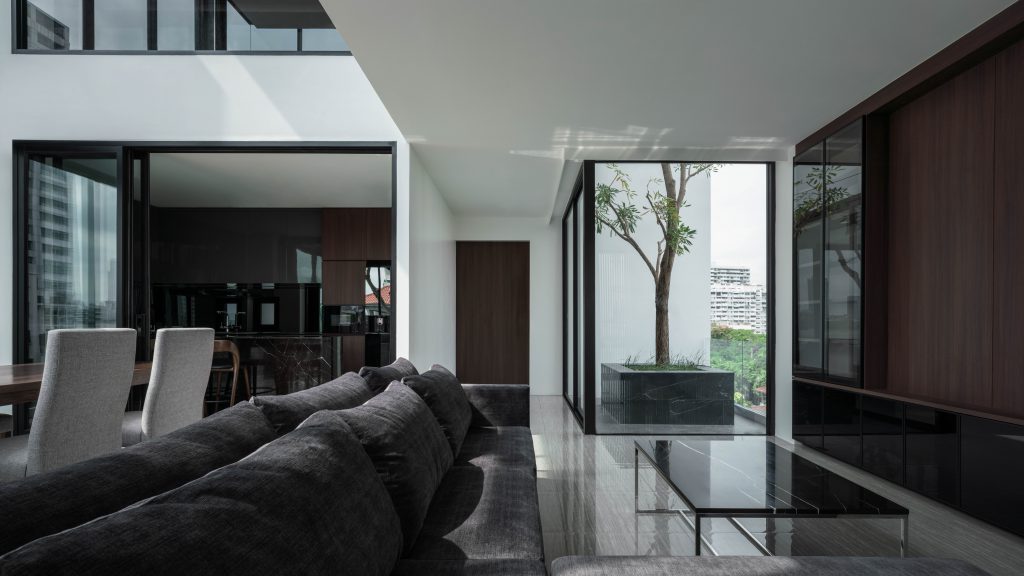
For many, a house is often concerned about its aesthetics. Many choose to define architecture from its visual appearance, which is undeniably an essential consideration as it is the visualization of a design perceived through our eyes. Yet, at the same time, it is not the only part of an architectural concept or design.
“The owners looked for a plot of land around here. Their brief was for a family home with an easy access route to the hospital for their parents. They also asked if it would be possible for the house to be used as a source of income post-retirement.” The architect, Ayutt Mahasom, explains how the design of the house originates and develops.
SETTHA House is a six-storey building designed by AAd (Ayutt and Associates Design) distinctively located on a corner land plot on Setthasiri road, Bangkok, near Vichaiyut Hospital. From the outside, the house resembles a group of buildings with partially obscured lower floors and opened upper floors. This provides a modern-looking appearance but is not the house’s only interesting quality. The concept behind this design element is just as brilliant as the smart design by the architect being able to resolve the limitations recognized and to be able to comply with the needs of the owners, both in terms of the dwelling and value-adding to the house design.
As family healthcare was paramount as part of the design brief and concept, the house is only 200 meters from the nearby hospital. Additionally, given that the empty plot originated as a daily and monthly rental parking lot, the architect saw the potential to adapt his design to create residential and commercial space.
Due to a limited site area of 300 square meters (75 sq.wah) and an extensive building setback due to roads on both sides, the house was designed vertically rather than horizontally to maximize available space. Utility spaces are clearly partitioned from the entrances, one for public and one for private. The latter is located deeper into the alley, thus improving the separation of interior spaces from through traffic. Although the utility spaces cannot connect, a sense of privacy is retained. Local Land Code regulations compel buildings to include separate sets of main and emergency stairs and place them within certain distances in a fire emergency. These regulations define the management of the design partitioning of the spaces.
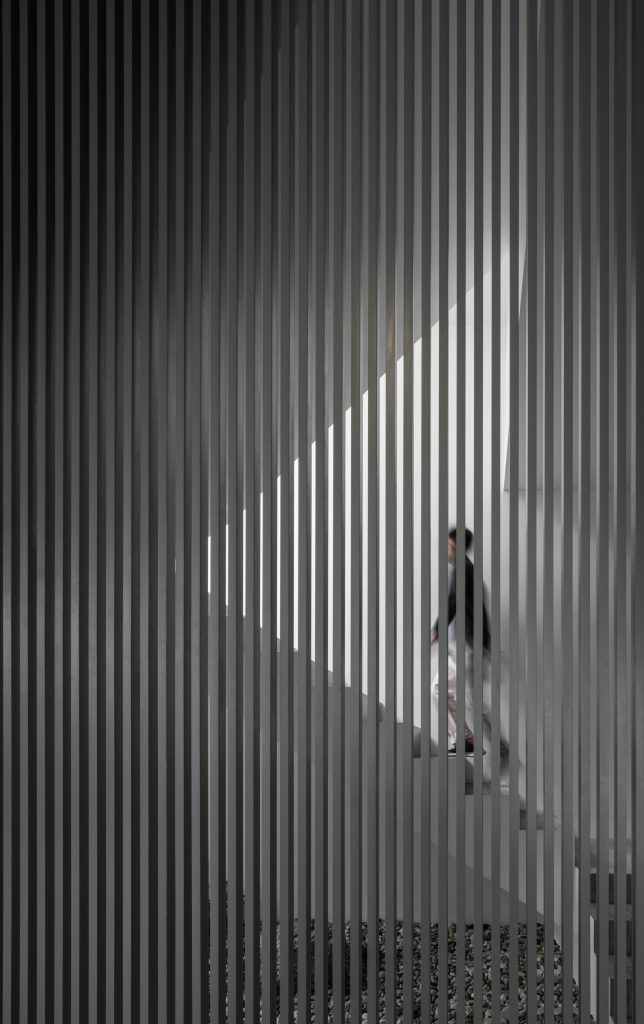
The first floor includes the rear entry and is a private zone where the owners can park two cars and access the private area by stair and elevator. The front area includes a parking lot for nine cars, given parking to service the many restaurants nearby. The design allows mechanical car lifters to increase future parking numbers to thirteen vehicles when installed. The architect ensured this by calculating the clear height required for the potential expansion if the need arises.
Moving from the first level parking lot to the second floor, you reach a planned multi-functional utility area that could be used for different purposes depending on tenant needs including co-working space, office area, and coffee shop. The area has an open plan that will adapt to the other uses. When the space is vacant, the owners can use the area as a private studio or personal office. This area is clearly secured in terms of accessibility from the remainder of the house area.
The third and fourth floors are designed as bedrooms for family members. The external glazed walls appear opaque from the outside while concealing activities inside the house. At the same time, the slatted signature fin facade used as a vital part of the design by AAd allows those inside clear vision to external activity without being seen. The design also allows natural light penetration while acting as a double façade system filtering the sunlight and minimizing heat gain and wind pressure that directly contact the glazed facade.
Apart from aesthetics, the system is designed to reduce the need to use a bind to shield the residents from direct sunlight and allow windows to take advantage of wanted external natural environment conditions. The fifth and sixth floors include the living room and the owner’s office space. These two floors have a rooftop terrace for outdoor activities. The area is fully open for unobstructed views without the slatted façade as the building itself shields this part of the house from street view, allowing the residents to fully appreciate the scenery and natural landscape. The soft landscape has always been a vital ingredient of AAd’s design works.
The same application is applied here for Settha House, where the upper floors recede from lower ones to make space for a roof garden on each floor to create continuous perspectives from each of the rooms for views of the landscape from all areas. The idea becomes even more interesting when the residents and passersby can view the green areas on the roofs and facade. In terms of access to healthcare, the interior circulation allows for a bed-sized elevator that can be used in the case of an emergency. The third-floor bedroom also caters to this through partitioning, creating a secondary space for nursing care when required. Planning also allows the owner to convert the unused space into a one or two-bedroom condominium – a flexible space design for the changes that possibly come in the future.
SETTHA House may be a little different from other works by AAd. Still, the value of this work reflects the owner’s need through the application of residential architecture that meets initial needs but remains flexible in design to accommodate future needs.



